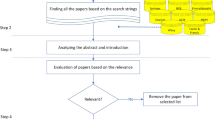Abstract
Sensing and monitoring information diffusion in online social networks is a complex problem of prominent importance, typically requiring significant sensing resources to address it properly. In this paper, we propose an inference approach for an information diffusion process where information is considered to belong to different classes, characterized by different spreading dynamics and possibly different topical content. Our framework utilizes social network analysis metrics in order to reduce the sensing resources that would be required in an otherwise exhaustive approach, while employing statistical learning and probabilistic inference for maintaining the accuracy of information tracking, whenever needed. The proposed framework defines an edge coloring scheme, based on which it is possible to keep track of information diffusion. We assume that the latter spreads according to various biased random walks that represent the dynamics of the considered classes of information. We have employed learning for the inference of those cases where backtracking leads to multiple potential choices for information paths. We demonstrate the operation and efficacy of our approach in characteristic online social networks, such as distributed wireless (spatial) and scale-free (relational) topologies, and draw conclusions on the impact of topology on information spreading. Finally, we discuss the emerging trends applicable for each topology and provide broader guidelines on the suitability of the proposed information diffusion inference scheme for each network.













Similar content being viewed by others
References
Gupta A, Jha RK (2015) A survey of 5G network: Architecture and emerging technologies. IEEE Access 3:1206–1232
Stai E, Karyotis V, Papavassiliou S (2016) A hyperbolic space analytics framework for big network data and their applications. IEEE Network Mag 30(1):11–17
Al-Fugaha A, Guizani M, Mohammadi M, Aledhari M, Ayyash M (2015) Internet of things: A survey on enabling technologies, protocols, and applications. IEEE Communications Surveys & Tutorials 17(4):2347–2376
Castro R, Coates M, Liang G, Novak R, Yu B (2004) Network Tomography: Recent developments. Stat Sci 19(3):499–517
Khelil A, Becker C, Tian J, Rothermel K (2002) An epidemic model for information diffusion in MANETs. In: Proceedings of the 5th ACM International Workshop on Modeling analysis and Simulation of Wireless and Mobile Systems (MSWiM), pp 54–60
Stai E, Karyotis V, Mpitsaki A-C, Papavassiliou S (2017) Strategy evolution of information diffusion under time-varying user behavior in generalized networks. Elsevier Computer Communications (ComCom) Journal 100:91–103
Guille A, Hacid H, Fabvre C, Zighed DA (2013) Information diffusion in online social networks: A survey. ACM SIGMOD Record 42(2):17–28
Karyotis V, (Arman) Khouzani MHR (2016) Malware diffusion models for modern complex networks theory and applications. Morgan Kaufmann (imprint of elsevier), Boston
Stai E, Karyotis V, Papavassiliou S (2015) User interest dictated information diffusion over generalized networks. In: Proceedings of the 2nd IEEE ICC Workshop on Dynamic Social Networks (DySON), pp 1554-1559, London, U.K.
Mayers S, Leskovec J (2012) Clash of the contagions: Cooperation and competition in information diffusion. In: Proceedings of ICDM
Lawrence E, Michailidis G, Nair VN, Xi B (2006) Network tomography: A review and recent developments. In: Fan, Koul (eds) Frontiers in Statistics, College Press, pp 345–364
Gomez-Rodriguez M, Leskovec J, Krause A (2012) Inferring networks of diffusion and influence. ACM Trans Knowl Discov Data (TKDD) 5(4):37. Article 21
Gomez-Rodriguez M, Leskovec J, Balduzzi D, Scholkopf B (2014) Uncovering the structure and temporal dynamics of information propagation. Netw Sci 2(1):26–65
Karyotis V, Stai E, Papavassiliou S (2013) Evolutionary dynamics of complex communications networks. CRC Press - Taylor & Francis Group, Boca Raton
Santi P (2012) Mobility models for next generation wireles networks: Ad hoc, vehicular, and mesh networks. Wiley, Chichester
Bettstetter C, Hartmann C (2005) Connectivity of wireless multihop networks in a shadow fading environment. Wirel Netw 11(5):571–579
Lu Z, Wen Y, Zhang W, Zheng Q, Cao G (2016) Towards information diffusion in mobile social networks. IEEE trans Mobile Computing 15(5):1292–1304
de Berg M, Cheong O, van Kreveld M, Overmars M (2008) Computational geometry: Algorithms and applications, 3rd edn. Springer, Berlin
Beraldi R (2009) Biased random walks in uniform wireless networks. IEEE Trans Mobile Computing 8 (4):500–513
Masuda N, Porter MA, Lambiotte R (2017) Random walks and diffusion on networks. Elsevier Physics Reports 716717:1–58
Ibe OC (2013) Elements of random walk and diffusion processes. Wiley, Hoboken
Rossi RA, Ahmed NK (2014) Coloring large complex networks, NK Soc Netw Anal Min
Freeman LC (1982) Centered graphs and the structure of ego networks. Math Soc Sci 3(3):291–304
Manning CD, Raghavan P, Schutze H (2008) Introduction to information retrieval. Cambridge University Press, Cambridge
Leskovec J, Krevl A (2014) SNAP datasets: Stanford large network dataset collection. http://snap.stanford.edu/data
Author information
Authors and Affiliations
Corresponding author
Additional information
Publisher’s Note
Springer Nature remains neutral with regard to jurisdictional claims in published maps and institutional affiliations.
This article is part of the Topical Collection: Special Issue on Network Coverage
Guest Editors: Shibo He, Dong-Hoon Shin, and Yuanchao Shu
Rights and permissions
About this article
Cite this article
Vitoropoulou, M., Karyotis, V. & Papavassiliou, S. Sensing and monitoring of information diffusion in complex online social networks. Peer-to-Peer Netw. Appl. 12, 604–619 (2019). https://doi.org/10.1007/s12083-018-0684-7
Received:
Accepted:
Published:
Issue Date:
DOI: https://doi.org/10.1007/s12083-018-0684-7




